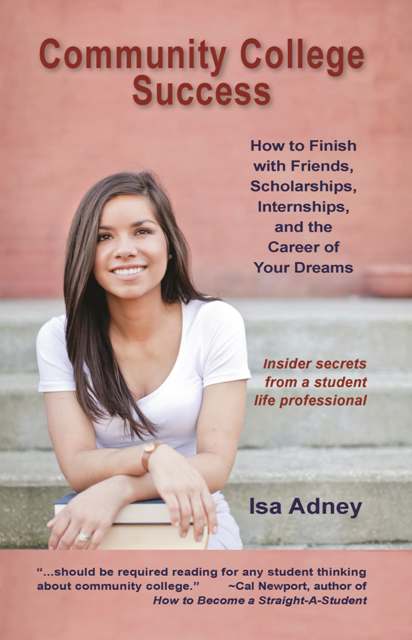Perusing the shelves of reference and study aid books at Barnes & Noble, between the MCAT and SAT books, there are a select few manuals to help college students. However, the vast majority of them have themes along the lines of: “How to survive living with a roommate,” and “How to get the most out of your meal plan/avoid the ‘freshman 15.’” I have never seen a book about how to survive community college. In fact, I asked if B&N sold anything of the sort, and the middle aged gentleman who helped me simply said: “… I’ve never heard of that.” So when I heard about Isa Adney’s book, Community College Success, I was pretty excited. On the cover, Adney claims that by reading the 167-page book, you’ll learn “How to finish with friends, scholarships, internships, and the career of your dreams.” That seems like a pretty big promise from a college student. But I have to say, I was not disappointed.
 I’ve said it about many a novel, but never a self-help book (until now); I couldn’t put it down. The reason being that I actually read the introduction. I never read intros, prologues, or prefaces; but I promised myself that if I was going to review this book, I would read the entire thing, cover to cover. In the intro, Adney talks about her journey through Seminole State College of Florida, and how her progress led her to Stetson University with a $110,000 scholarship. “On my first day of community college, I cried like a little girl.” The very first sentence of the book still resonates with me. I didn’t actually cry on my first day of community college, but I felt like it. I had gone through high school with the mindset that only losers go to community college, so when I found myself sitting in a classroom of one, that’s exactly what I felt like. “I also ended my community college experience with crying-on graduation when the president announced I’d won the $110,000 Jack Kent Cooke scholarship.” The Jack Kent Cooke foundation is no joke. A designated faculty member from their college must nominate students, and only 50 students in the country are selected for the super prestigious transfer scholarship.
I’ve said it about many a novel, but never a self-help book (until now); I couldn’t put it down. The reason being that I actually read the introduction. I never read intros, prologues, or prefaces; but I promised myself that if I was going to review this book, I would read the entire thing, cover to cover. In the intro, Adney talks about her journey through Seminole State College of Florida, and how her progress led her to Stetson University with a $110,000 scholarship. “On my first day of community college, I cried like a little girl.” The very first sentence of the book still resonates with me. I didn’t actually cry on my first day of community college, but I felt like it. I had gone through high school with the mindset that only losers go to community college, so when I found myself sitting in a classroom of one, that’s exactly what I felt like. “I also ended my community college experience with crying-on graduation when the president announced I’d won the $110,000 Jack Kent Cooke scholarship.” The Jack Kent Cooke foundation is no joke. A designated faculty member from their college must nominate students, and only 50 students in the country are selected for the super prestigious transfer scholarship.
Adney grew up in a family that from a socio-economic point-of-view would have been lower-middle class. Her high school had an astonishingly low graduation rate, at only 25%. During her high school years, Adney’s family suffered financially from unforeseen, and tragically expensive medical bills. Her two younger brothers were plagued with mysterious illnesses. Tito, the youngest, had food poisoning. The bacteria in his stomach spread to his spine, leaving him paralyzed for several months. Just a few months later, her four-year-old brother, Robby, started having seizures and was later diagnosed with Epilepsy. Both of her brothers fully recovered, but her family’s finances never really did. Although Isa acknowledged that her lack of funds would put her at a disadvantage (like not being able to go to the school she was accepted to because of the $25,000 price tag) she wasn’t discouraged: “Even though the playing field wasn’t always fair, that didn’t mean I couldn’t win.” And win she did. Adney leads into the book with one last quote: “Whether you leave with a two-year vocational degree, a bachelor’s degree, or go all the way to your Ph.D., I want to make sure you do it with fire and passion, knowing you’ve found something worthy of your energy, sacrifice, and attention.”
Chapter 1: “Do You Want Fries with That? Why Drive-Thru Education Isn’t Enough” talks about the importance of going above and beyond in college. Adney says, “While every student has life circumstances that affect her ability to get involved and engaged in the college campus, every student can do something extra. Each student must do something extra. As Thomas Friedman said, ‘The age of average is over.’” Adney adds that we’re now in what she calls “the age of extra.” Chapters one and two cover the same terrain: how making friends can help you out. Adney talks about the phenomena that encompasses teenagers in high school making friends easily because they’re packed in classrooms like sardines, with the same people for eight hours a day, for four years. But that changes when you enter college. Classes are between 50 minutes and, if you’re really unlucky, up to three hours, once to twice a week. Outside of that class time, it’s up to the student to meet people, and that’s nearly impossible if you’re not involved in some campus organization(s). “Though the community college culture is often defined by the-go-to-class-go-home routine, you can change it… One pebble can make waves.”
Chapter 3: How joining clubs can help you soar. “As president of the Pi Lambda chapter of Phi Theta Kappa, I was given the opportunity to fly to Nashville, Tennessee for the international convention… Had I not followed a classmate I barely knew to a Phi Theta Kappa chapter meeting, I would have missed that adventure.” Many students have the mindset that what you don’t do won’t hurt you as much as what you do incorrectly, but that’s not true. The whole premise of Isa Adney’s book is that to succeed, you have to be assertive. People aren’t going to knock on your door and ask if you want a scholarship, a job, or to be president of an honor society. Adney took her own advice, and after graduating from Stetson, she successfully transferred to the University of Illinois at Urbana-Champaign, where she is currently working toward her M.Ed in training and development, while also working at Seminole State College of Florida as a student life coordinator.
You can pick up a copy of Community College Success at most booksellers, and find out how to get jobs, internships, talk to strangers (scary, right?), and befriend your professors, plus SO much more. Also, check out Isa Adney’s blog.
Emily Duren is a sophomore and Mass Communications major at Hillsborough Community College in Tampa, Florida. When not in class or studying for her honors classes, Emily is the Editor-in-Chief of The Hawkeye at HCC, and president of the media club. In her spare time, Emily enjoys working out, drawing, reading books, and writing one.

